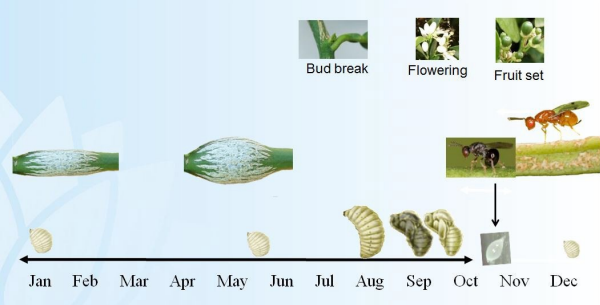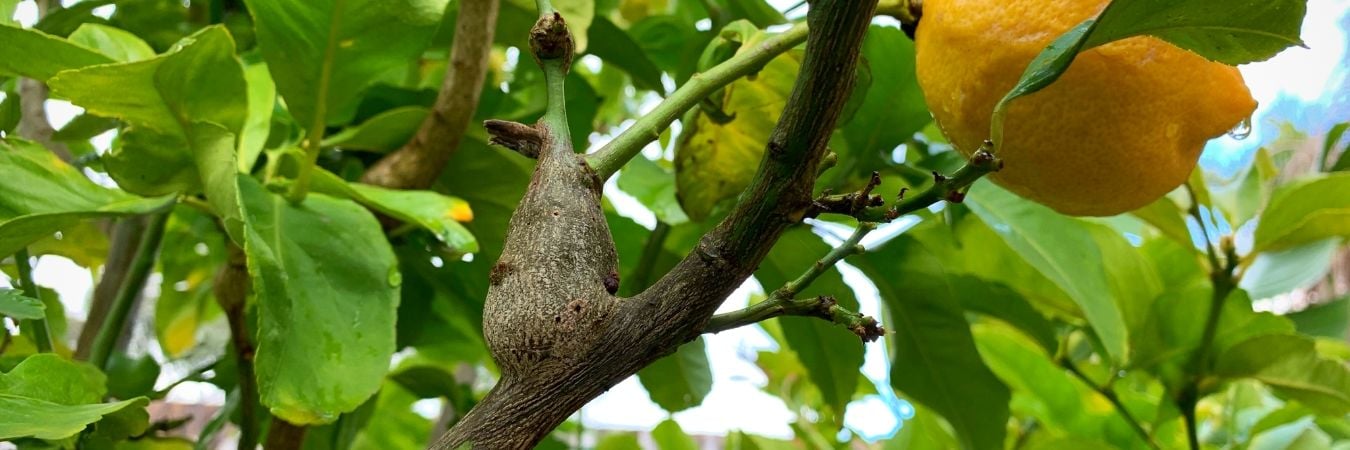Citrus gall wasp (Bruchophagus fellis) affects all types of citrus across Australia. The wasp produces lumpy, woody galls around their larvae on branches. The galls weaken the trees, making them produce less fruit and sometimes causing branch dieback.
Urban gardeners are encouraged to act now to stop the spread of this pest. Monitoring your trees and implementing simple controls can keep your trees healthy and productive and reduce the threat to the citrus industry across Australia.
Understanding the lifecycle of the wasp helps us to understand the best time of year for controls. Both cultural and chemical practices can be used, depending on how severe the problem is.

Citrus gall wasp life-cycle Source: DPI NSW
Adult citrus gall wasps emerge from galls in spring – usually between mid October to mid December in southern Australia, and are most abundant for about a month – from late October to mid November. Once the wasp has emerged, it has about a week to mate and lay up to 100 eggs under the green bark of a citrus tree. The eggs hatch after 2 to 3 weeks and feed within the stem for about 9-10 months. Over these months, the tree promotes woody growth around the infected area. The galls start to be seen from December through April and will gradually get bigger through autumn and winter. After a short pupation period in spring, the adults emerge from little holes in the galls and the cycle continues.
With this life-cycle in mind, there are a few things to consider to manage the pest:
- Time your pruning: The best time to prune out galls is from April to June. Pruning in winter beyond June causes the tree to grow vigorously in spring and resulting in a flush of new foliage that the gall wasp prefers.
- Burn or bake gall-infected off-cuts: Treat gall-affected branches before disposal by placing them in a well-sealed plastic bag in the sun to bake for a month, or incinerate them. Wasps can still emerge from galls in pruning off-cuts. Disposing of gall off-cuts in normal household waste, a green verge collection or in garden bags will spread the pest to other areas
- Fertilising: Avoid heavily fertilising trees in winter or spring, which will promote excessive fresh growth that the wasp prefers.
- Don’t prune every year: Citrus gall wasps like to stay close to home and in many cases, the same tree, so yearly pruning regimes which encourage fresh growth can perpetuate the gall wasp cycle.
- Check your trees: Galls in newly-infested branches are small and difficult to see. Check for light-green coloured shoots coming out at right angles from branches (spring to early autumn). Monitor all citrus trees all year round.
- Community involvement: involve your neighbours in monitoring and managing the pest as well. Coordinating control with your neighbours will mean less wasps to lay eggs to create galls in the following season.
- Natural enemies wasps Megastigmus brevivalvus and M. trisulcus insert their eggs directly into the eggs of gall wasps where they slowly develop in the host larva, eventually killing it. Chemicals for gall wasp control will also affect the Megastigmus.
- Deter egg laying petroleum spray oils used against other citrus insect pests can deter gall wasp adults from laying eggs, as can calcined Kaolin clay.

Citrus gall wasp management calendar Source: DPIRD
Report galls to MyPestGuide Reporter.
Further Information
State government websites in New South Wales, South Australia and Western Australia have fact sheets of further information on Citrus gall wasp.
Take a look at our Citrus gall wasp factsheet.


4 comments, add yours.
Menards Near Me
Hello. This post was extremely interesting, particularly because I was
looking for thoughts on this subject last Thursday.
Best regards,
Harrell Henneberg
Judith
Thanks for the info, my young lemon tree has galls in the top new growth. I’ve used a vegi peeler to open the gall but I’ve just noticed another one forming. Should I prune the affected branches completely?
Sarah Brown
Hi Judith, thanks for reaching out. We have sent your question to one of our Community of Practice members at Citrus Australia and this is their response: “I would suggest they remove branch from just below the gall, the vegie peeler approach will help but can’t be sure of exposing all the eggs/larvae. As per the article new growth is always going to attract CGW, but you can’t grow a tree without new growth. CGW is a native insect, there is some work on bio control with natural enemies but to have the enemies you need the pest. Unless the neighbourhood all work together chemical control won’t work as they will fly in from next door.”
Fran Kish
Hello I’ve had gall wasp in my lemon tree nearly two years ago. We pruned off one third of the tree. It’s soooooo sad looks like the whole tree has die back should we pull out tree and buy a new one. Ver spindly weak growth ATM. Sad😢 Thank you